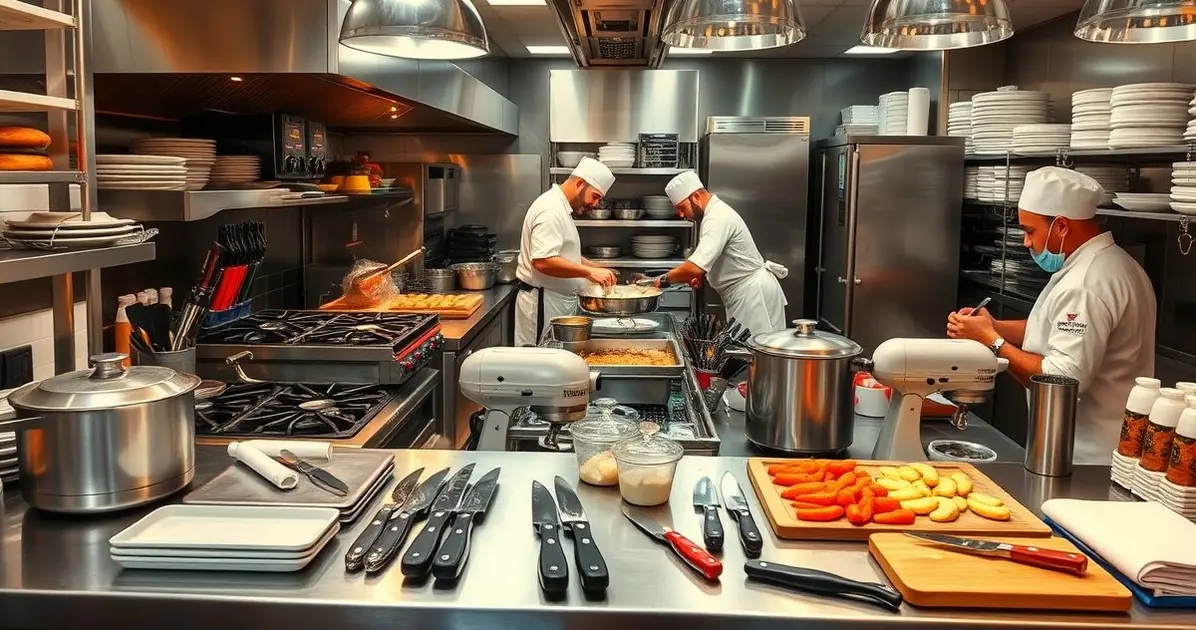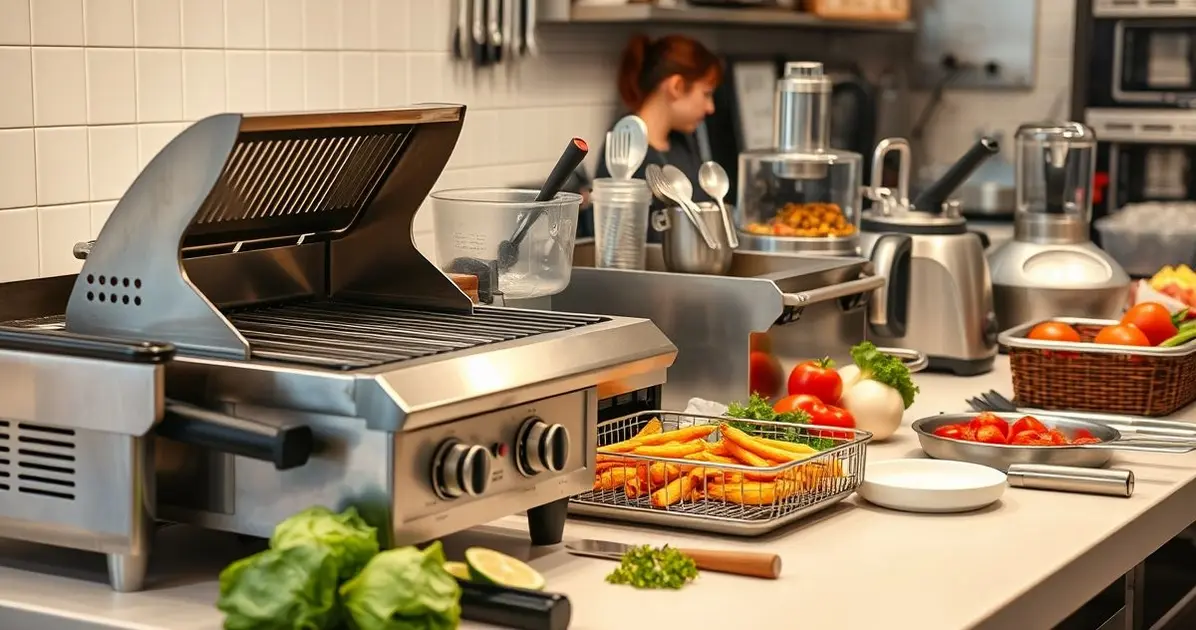Commercial cooking relies on a wide variety of specialized tools and equipment designed to enhance efficiency and productivity in food preparation and service. These essentials form the backbone of professional kitchens.
What are tools and equipment in commercial cooking

The tools and equipment in commercial cooking include high-powered appliances, such as ovens and grills, along with various utensils like knives, spatulas, and pots. These tools ensure chefs can prepare meals quickly and efficiently while maintaining high standards of quality.
Overview of Basic Kitchen Utensils
Basic kitchen utensils are fundamental tools that every commercial kitchen should have. These utensils enhance efficiency in food preparation and ensure that tasks are performed safely and effectively. Here’s an overview of basic kitchen utensils:
1. Chef’s Knife:
- Versatility: The chef’s knife is a multipurpose tool used for chopping, slicing, and dicing a variety of ingredients. Its broad blade allows for a rocking motion, making it ideal for quick and efficient cutting.
2. Paring Knife:
- Precision: A paring knife is smaller than a chef’s knife and is perfect for intricate tasks such as peeling fruits and vegetables or removing seeds. It offers greater control for detailed work.
3. Cutting Boards:
- Safety: Cutting boards provide a safe surface for chopping and slicing. It’s advisable to use separate boards for raw meats and vegetables to prevent cross-contamination.
4. Mixing Spoons:
- Material Variety: Mixing spoons come in various materials, including wood, silicone, and stainless steel. They are essential for stirring and combining ingredients.
5. Spatulas:
- Types: Spatulas come in various forms, including turners for flipping food and rubber spatulas for scraping bowls. A good set of spatulas is essential for cooking and baking tasks.
6. Whisks:
- Mixing and Aerating: Whisks are ideal for beating eggs, mixing batter, and incorporating air into mixtures. They come in various sizes and materials to suit different tasks.
7. Ladles:
- Serving Soups and Sauces: Ladles are perfect for serving soups, stews, and sauces. They allow for easy portioning and serving of liquid-based dishes.
8. Tongs:
- Versatile Handling: Tongs are handy for flipping, turning, and serving food. They provide a secure grip on ingredients and are especially useful for grilling, frying, or tossing salads.
By equipping your commercial kitchen with these basic kitchen utensils, you can enhance your cooking efficiency and make food preparation more enjoyable. Each tool serves a specific purpose, contributing to the overall success of your culinary endeavors!
Importance of Specialized Cooking Equipment
The importance of specialized cooking equipment in a kitchen cannot be overstated. These tools are designed to enhance efficiency, improve cooking performance, and simplify complex tasks. Here are several reasons why investing in specialized cooking equipment is essential:
1. Efficiency in Food Preparation:
- Time-Saving: Specialized equipment, such as food processors and immersion blenders, can significantly reduce the time spent on meal prep by performing tasks quickly and efficiently.
- Streamlined Processes: Equipment like mandolin slicers and spiralizers allow for quick and uniform cutting, making it easier to prepare ingredients for cooking.
2. Enhanced Cooking Techniques:
- Precision Cooking: Tools such as sous-vide machines and digital thermometers allow for precise temperature control, ensuring that meats and vegetables are cooked perfectly every time.
- Versatile Cooking Methods: Appliances like Instant Pots and slow cookers provide multiple cooking functions, allowing you to experiment with various techniques and recipes.
3. Improved Food Quality:
- Consistent Results: Specialized equipment helps achieve consistent cooking results. For example, using a high-quality blender ensures smooth textures in soups and sauces.
- Flavor Enhancement: Certain tools, like steamers, preserve the nutrients and flavors of vegetables, contributing to healthier and tastier meals.
4. Safety and Convenience:
- Built-In Safety Features: Many specialized cooking appliances come with safety features, such as automatic shut-off or cool-touch handles, which enhance safety in the kitchen.
- Ease of Use: Specialized gadgets are designed to simplify cooking tasks, making it easier for both novice cooks and experienced chefs to prepare meals.
5. Encouragement to Experiment:
- Inspiration for Creativity: Having specialized equipment encourages you to try new recipes and cooking techniques, fostering creativity in the kitchen.
- Expanding Culinary Skills: Using specialized tools can help you learn new cooking methods and improve your overall culinary skills.
In summary, the importance of specialized cooking equipment lies in its ability to enhance efficiency, improve cooking techniques, and ensure food quality. By investing in the right tools for your kitchen, you can streamline your cooking processes, elevate your culinary creations, and enjoy a more rewarding cooking experience!

How Tools Enhance Food Preparation and Presentation
Using the right tools in the kitchen can significantly enhance both food preparation and presentation. Here’s how various cooking tools contribute to these aspects:
1. Efficiency in Food Preparation:
- Time-Saving: Specialized tools like food processors and mandolin slicers speed up the preparation process, allowing you to chop, slice, and mix ingredients in a fraction of the time.
- Consistency: Tools such as measuring cups and scales ensure that ingredients are measured accurately, leading to consistent results in your dishes.
- Ease of Use: Ergonomically designed utensils, such as peelers and graters, make food preparation easier and more comfortable, reducing strain and improving efficiency.
2. Improving Food Quality:
- Precision Cutting: Sharp knives and specialized cutting tools allow for precise cuts, which enhances the texture and flavor of the ingredients, contributing to better overall quality in the final dish.
- Proper Cooking Techniques: Using the right cookware, like non-stick pans or cast iron skillets, ensures that food is cooked evenly and retains its natural flavors.
3. Enhancing Presentation:
- Visual Appeal: Tools like mandolin slicers create uniform slices that improve the visual presentation of dishes, making them more attractive to serve.
- Plating Tools: Using tweezers, squeeze bottles, or molds can help in arranging food artfully on the plate, elevating the overall dining experience.
- Garnishing Tools: Specialized gadgets for garnishing, such as zesters and herb scissors, allow you to add finishing touches that enhance the visual appeal of your dishes.
4. Encouraging Creativity:
- Experimentation: Having a variety of tools encourages you to experiment with different cooking techniques and presentations, fostering creativity in the kitchen.
- Unique Dishes: Specialized tools can help you create unique dishes that stand out, whether through innovative cooking methods or artistic plating.
In summary, the right tools not only streamline food preparation but also enhance the quality and presentation of your dishes. By investing in quality kitchen tools and utilizing them effectively, you can elevate your cooking and impress your guests with beautifully prepared meals!
Optimizing Kitchen Operations with the Right Tools
Optimizing kitchen operations is essential for both efficiency and productivity, especially in a busy cooking environment. The right tools play a crucial role in achieving this optimization. Here’s how you can enhance your kitchen operations with the right tools:
1. Streamlined Workflow:
- Task Organization: Using specialized tools for specific tasks (e.g., food processors for chopping, blenders for mixing) helps streamline workflow, allowing cooks to move efficiently from one task to another.
- Designated Stations: Setting up designated cooking stations equipped with the necessary tools minimizes movement and saves time during meal preparation.
2. Time Management:
- Quick Preparation: Tools like immersion blenders and food processors reduce prep time, enabling cooks to focus on cooking rather than chopping and mixing.
- Timers and Thermometers: Using timers and digital thermometers ensures that cooking times and temperatures are monitored accurately, preventing overcooking or undercooking.
3. Enhanced Safety:
- Proper Tools for Safety: Using the right tools, such as cut-resistant gloves and ergonomic utensils, can help prevent accidents and injuries in the kitchen.
- Organized Storage: Keeping tools organized and easily accessible reduces the risk of accidents caused by searching for items or tripping over clutter.
4. Improved Quality Control:
- Consistent Measurements: Utilizing measuring cups, spoons, and kitchen scales ensures accurate ingredient measurements, leading to consistent results in recipes.
- Regular Maintenance: Keeping tools in good condition through regular maintenance helps ensure that they perform optimally, contributing to the overall quality of dishes.
5. Encouraging Collaboration:
- Shared Tools: Having sufficient tools available for multiple cooks fosters collaboration and teamwork in the kitchen, allowing for efficient meal preparation.
- Training on Tools: Providing training on how to use tools effectively helps staff work together more efficiently and safely.
6. Flexibility and Adaptability:
- Multi-Functional Equipment: Investing in multi-functional tools, such as an Instant Pot or food processor, enhances flexibility in cooking methods and allows for a wider variety of dishes to be prepared.
- Adjusting to Needs: Being able to adapt your kitchen operations based on the tools available ensures that you can handle different types of meals and cooking styles.
In summary, optimizing kitchen operations with the right tools is crucial for enhancing efficiency, safety, and overall productivity in the cooking environment. By investing in quality tools, organizing your kitchen effectively, and ensuring proper training, you can create a streamlined and successful culinary operation that meets the demands of any kitchen!
Conclusion
In conclusion, optimizing kitchen operations with the right tools is essential for creating an efficient, safe, and productive cooking environment.
By selecting specialized tools that streamline food preparation and enhance workflow, you can significantly improve the overall efficiency of your kitchen.
Investing in quality equipment, such as food processors, timers, and ergonomic utensils, not only saves time but also ensures consistent results in your culinary creations.
Regular maintenance and proper organization further contribute to a safe and enjoyable cooking experience.
Whether you are a novice home cook or a seasoned professional, embracing these practices will elevate your culinary skills and enhance your kitchen operations.
By prioritizing the right tools and techniques, you can create delicious meals with ease and confidence, making your kitchen a place of creativity and joy!
FAQ – Frequently Asked Questions about Kitchen Tools and Equipment Maintenance
Bakit mahalaga ang tamang pagpili ng kagamitan sa kusina?
Mahalaga ang tamang pagpili ng kagamitan upang mapabuti ang iyong karanasan sa pagluluto, matiyak ang kaligtasan, at pahabain ang buhay ng mga kagamitan.
Ano ang mga pangunahing kagamitan sa pagluluto na dapat mayroon sa kusina?
Kabilang sa mga pangunahing kagamitan ang mga kutsilyo, cutting boards, pots at pans, utensils, at measuring tools.
Paano ko mapapanatiling malinis ang aking mga kagamitan sa pagluluto?
Magsagawa ng regular na paglilinis, i-sanitize ang mga kagamitan, at tiyaking tuyo ang mga ito bago itago.
Gaano kadalas dapat suriin ang mga kagamitan sa kusina para sa wear and tear?
Dapat regular na suriin ang mga kagamitan, lalo na ang mga kutsilyo at non-stick cookware, para sa mga senyales ng wear and tear.
Ano ang mga tips para sa tamang pag-iimbak ng mga kagamitan sa kusina?
Siguraduhing tuyo ang mga kagamitan bago itago, gumamit ng tamang storage solutions, at regular na suriin ang mga ito para sa wear and tear.
Paano ko mapapanatiling ligtas ang aking kusina mula sa foodborne illnesses?
Magsagawa ng regular na sanitization ng mga surfaces at kagamitan, at sundin ang mga best practices sa food safety.
See more
Discover plenty of easy and delicious recipes you can make at home, from hearty dinners to indulgent desserts and wholesome breakfasts.




